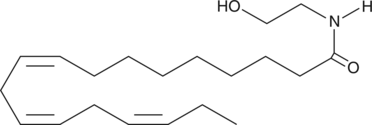Chemicals
Showing 40801–40950 of 41137 results
-
Tamoxifen (Item No. 13258) is a selective estrogen receptor (ER) modulator that is widely used in the therapeutic and chemopreventive treatment of breast cancer. Although it is an antagonist of ER action in breast tissue, it acts as an ER agonist in bone and blood vessels and a partial ER agonist in uterine tissues. α-hydroxy Tamoxifen is a reactive metabolite of tamoxifen that is formed by the action of cytochrome P450 3A4 in human liver.{28206,28212} It can be further converted into genotoxic DNA adducts though a mechanism involving reversible O-sulfonation of the hydroxyl moiety, which in rats has been linked with hepatocarcinoma.{28206,28207,28208,28209,28211}
Brand:CaymanSKU:-Out of stock
Tamoxifen (Item No. 13258) is a selective estrogen receptor (ER) modulator that is widely used in the therapeutic and chemopreventive treatment of breast cancer. Although it is an antagonist of ER action in breast tissue, it acts as an ER agonist in bone and blood vessels and a partial ER agonist in uterine tissues. α-hydroxy Tamoxifen is a reactive metabolite of tamoxifen that is formed by the action of cytochrome P450 3A4 in human liver.{28206,28212} It can be further converted into genotoxic DNA adducts though a mechanism involving reversible O-sulfonation of the hydroxyl moiety, which in rats has been linked with hepatocarcinoma.{28206,28207,28208,28209,28211}
Brand:CaymanSKU:-Out of stock
Tamoxifen (Item No. 13258) is a selective estrogen receptor (ER) modulator that is widely used in the therapeutic and chemopreventive treatment of breast cancer. Although it is an antagonist of ER action in breast tissue, it acts as an ER agonist in bone and blood vessels and a partial ER agonist in uterine tissues. α-hydroxy Tamoxifen is a reactive metabolite of tamoxifen that is formed by the action of cytochrome P450 3A4 in human liver.{28206,28212} It can be further converted into genotoxic DNA adducts though a mechanism involving reversible O-sulfonation of the hydroxyl moiety, which in rats has been linked with hepatocarcinoma.{28206,28207,28208,28209,28211}
Brand:CaymanSKU:-Out of stock
Tamoxifen (Item No. 13258) is a selective estrogen receptor (ER) modulator that is widely used in the therapeutic and chemopreventive treatment of breast cancer. Although it is an antagonist of ER action in breast tissue, it acts as an ER agonist in bone and blood vessels and a partial ER agonist in uterine tissues. α-hydroxy Tamoxifen is a reactive metabolite of tamoxifen that is formed by the action of cytochrome P450 3A4 in human liver.{28206,28212} It can be further converted into genotoxic DNA adducts though a mechanism involving reversible O-sulfonation of the hydroxyl moiety, which in rats has been linked with hepatocarcinoma.{28206,28207,28208,28209,28211}
Brand:CaymanSKU:-Out of stock
α-Hydroxyglutaric acid (2-HG) is an α-hydroxy acid. It is metabolized to 2-oxoglutarate by D- and L-2-hydroxyglutarate dehydrogenases, and mutations in these enzymes lead to 2-hydroxyglutaric aciduria, a neurometabolic disorder characterized by increased levels of L-2-hydroxyglutaric acid (Item No. 21123).{26770,26771,26772} 2-HG can also be metabolized from isocitrate by mutated forms of isocitrate dehydrogenase 1 (IDH1) and IDH2.{26773,26775} 2-HG is structurally similar to α-ketoglutarate, the product of wild-type isocitrate dehydrogenases, and competitively inhibits α-ketoglutarate-dependent dioxygenases, including histone lysine demethylases and DNA hydroxylases.{26775,26774,26769}
Brand:CaymanSKU:25894 - 10 mgAvailable on backorder
α-Hydroxyglutaric acid (2-HG) is an α-hydroxy acid. It is metabolized to 2-oxoglutarate by D- and L-2-hydroxyglutarate dehydrogenases, and mutations in these enzymes lead to 2-hydroxyglutaric aciduria, a neurometabolic disorder characterized by increased levels of L-2-hydroxyglutaric acid (Item No. 21123).{26770,26771,26772} 2-HG can also be metabolized from isocitrate by mutated forms of isocitrate dehydrogenase 1 (IDH1) and IDH2.{26773,26775} 2-HG is structurally similar to α-ketoglutarate, the product of wild-type isocitrate dehydrogenases, and competitively inhibits α-ketoglutarate-dependent dioxygenases, including histone lysine demethylases and DNA hydroxylases.{26775,26774,26769}
Brand:CaymanSKU:25894 - 25 mgAvailable on backorder
α-Hydroxyglutaric acid (2-HG) is an α-hydroxy acid. It is metabolized to 2-oxoglutarate by D- and L-2-hydroxyglutarate dehydrogenases, and mutations in these enzymes lead to 2-hydroxyglutaric aciduria, a neurometabolic disorder characterized by increased levels of L-2-hydroxyglutaric acid (Item No. 21123).{26770,26771,26772} 2-HG can also be metabolized from isocitrate by mutated forms of isocitrate dehydrogenase 1 (IDH1) and IDH2.{26773,26775} 2-HG is structurally similar to α-ketoglutarate, the product of wild-type isocitrate dehydrogenases, and competitively inhibits α-ketoglutarate-dependent dioxygenases, including histone lysine demethylases and DNA hydroxylases.{26775,26774,26769}
Brand:CaymanSKU:25894 - 5 mgAvailable on backorder
α-Hydroxyglutaric acid (2-HG) is an α-hydroxy acid. It is metabolized to 2-oxoglutarate by D- and L-2-hydroxyglutarate dehydrogenases, and mutations in these enzymes lead to 2-hydroxyglutaric aciduria, a neurometabolic disorder characterized by increased levels of L-2-hydroxyglutaric acid (Item No. 21123).{26770,26771,26772} 2-HG can also be metabolized from isocitrate by mutated forms of isocitrate dehydrogenase 1 (IDH1) and IDH2.{26773,26775} 2-HG is structurally similar to α-ketoglutarate, the product of wild-type isocitrate dehydrogenases, and competitively inhibits α-ketoglutarate-dependent dioxygenases, including histone lysine demethylases and DNA hydroxylases.{26775,26774,26769}
Brand:CaymanSKU:-Out of stock
α-Hydroxyglutaric acid (2-HG) is an α-hydroxy acid. It is metabolized to 2-oxoglutarate by D- and L-2-hydroxyglutarate dehydrogenases, and mutations in these enzymes lead to 2-hydroxyglutaric aciduria, a neurometabolic disorder characterized by increased levels of L-2-hydroxyglutaric acid (Item No. 21123).{26770,26771,26772} 2-HG can also be metabolized from isocitrate by mutated forms of isocitrate dehydrogenase 1 (IDH1) and IDH2.{26773,26775} 2-HG is structurally similar to α-ketoglutarate, the product of wild-type isocitrate dehydrogenases, and competitively inhibits α-ketoglutarate-dependent dioxygenases, including histone lysine demethylases and DNA hydroxylases.{26775,26774,26769}
Brand:CaymanSKU:-Out of stock
α-Hydroxyglutaric acid (2-HG) is an α-hydroxy acid. It is metabolized to 2-oxoglutarate by D- and L-2-hydroxyglutarate dehydrogenases, and mutations in these enzymes lead to 2-hydroxyglutaric aciduria, a neurometabolic disorder characterized by increased levels of L-2-hydroxyglutaric acid (Item No. 21123).{26770,26771,26772} 2-HG can also be metabolized from isocitrate by mutated forms of isocitrate dehydrogenase 1 (IDH1) and IDH2.{26773,26775} 2-HG is structurally similar to α-ketoglutarate, the product of wild-type isocitrate dehydrogenases, and competitively inhibits α-ketoglutarate-dependent dioxygenases, including histone lysine demethylases and DNA hydroxylases.{26775,26774,26769}
Brand:CaymanSKU:-Out of stock
α-Hydroxyglutaric acid (2-HG) is an α-hydroxy acid. It is metabolized to 2-oxoglutarate by D- and L-2-hydroxyglutarate dehydrogenases, and mutations in these enzymes lead to 2-hydroxyglutaric aciduria, a neurometabolic disorder characterized by increased levels of L-2-hydroxyglutaric acid (Item No. 21123).{26770,26771,26772} 2-HG can also be metabolized from isocitrate by mutated forms of isocitrate dehydrogenase 1 (IDH1) and IDH2.{26773,26775} 2-HG is structurally similar to α-ketoglutarate, the product of wild-type isocitrate dehydrogenases, and competitively inhibits α-ketoglutarate-dependent dioxygenases, including histone lysine demethylases and DNA hydroxylases.{26775,26774,26769}
Brand:CaymanSKU:-Out of stock
α-Hydroxymethyl atropine is a byproduct in the synthesis of atropine.{39650} It reduces acetylcholine-induced contractile activity of isolated rat intestine when used at a concentration of 0.025 ng/ml.{39651}
Brand:CaymanSKU:24266 - 25 mgAvailable on backorder
α-Hydroxymethyl atropine is a byproduct in the synthesis of atropine.{39650} It reduces acetylcholine-induced contractile activity of isolated rat intestine when used at a concentration of 0.025 ng/ml.{39651}
Brand:CaymanSKU:24266 - 50 mgAvailable on backorder
α-Isopropylaminohexanophenone (hydrochloride) (Item No. 31005) is an analytical reference standard categorized as a cathinone. This product is intended for research and forensic applications.
Brand:CaymanSKU:31005 - 1 mgAvailable on backorder
α-Isopropylaminohexanophenone (hydrochloride) (Item No. 31005) is an analytical reference standard categorized as a cathinone. This product is intended for research and forensic applications.
Brand:CaymanSKU:31005 - 5 mgAvailable on backorder
α-Isopropylaminopentiophenone (hydrochloride) (Item No. 20021) is an analytical reference standard that is structurally classified as a cathinone. The physiological and toxicological properties of this compound are not known. This product is intended for forensic and research applications.
Brand:CaymanSKU:20021 -Available on backorder
α-Isopropylaminopentiophenone (hydrochloride) (Item No. 20021) is an analytical reference standard that is structurally classified as a cathinone. The physiological and toxicological properties of this compound are not known. This product is intended for forensic and research applications.
Brand:CaymanSKU:20021 -Available on backorder
α-Linolenic acid (ALA) is an essential ω-3 polyunsaturated fatty acid found in plants.{42925} In vivo, it is converted to the longer-chain fatty acids eicosapentaenoic (Item Nos. 90110 | 90110.1 | 21908), docosapentaenoic (Item Nos. 90165 | 21907), and docosahexaenoic acid (Item No. 90310).{42926} It is also catabolized via fatty acid β-oxidation for energy or the synthesis of saturated and monounsaturated fatty acids, or stored in adipose tissue. Dietary consumption of α-linolenic acid-containing foods is positively associated with a moderately lower risk of cardiovascular disease.{42925}
Brand:CaymanSKU:90210 - 100 mgAvailable on backorder
α-Linolenic acid (ALA) is an essential ω-3 polyunsaturated fatty acid found in plants.{42925} In vivo, it is converted to the longer-chain fatty acids eicosapentaenoic (Item Nos. 90110 | 90110.1 | 21908), docosapentaenoic (Item Nos. 90165 | 21907), and docosahexaenoic acid (Item No. 90310).{42926} It is also catabolized via fatty acid β-oxidation for energy or the synthesis of saturated and monounsaturated fatty acids, or stored in adipose tissue. Dietary consumption of α-linolenic acid-containing foods is positively associated with a moderately lower risk of cardiovascular disease.{42925}
Brand:CaymanSKU:90210 - 250 mgAvailable on backorder
α-Linolenic acid (ALA) is an essential ω-3 polyunsaturated fatty acid found in plants.{42925} In vivo, it is converted to the longer-chain fatty acids eicosapentaenoic (Item Nos. 90110 | 90110.1 | 21908), docosapentaenoic (Item Nos. 90165 | 21907), and docosahexaenoic acid (Item No. 90310).{42926} It is also catabolized via fatty acid β-oxidation for energy or the synthesis of saturated and monounsaturated fatty acids, or stored in adipose tissue. Dietary consumption of α-linolenic acid-containing foods is positively associated with a moderately lower risk of cardiovascular disease.{42925}
Brand:CaymanSKU:90210 - 50 mgAvailable on backorder
α-Linolenic acid is an essential ω-3 polyunsaturated fatty acid found in plants.{42925} In vivo, it is converted to the longer-chain fatty acids eicosapentaenoic (Item Nos. 90110 | 90110.1 | 21908), docosapentaenoic (Item Nos. 90165 | 21907), and docosahexaenoic acid (Item No. 90310).{42926} It is also catabolized via fatty acid β-oxidation for energy or the synthesis of saturated and monounsaturated fatty acids, or stored in adipose tissue. Dietary consumption of α-linolenic acid-containing foods is positively associated with a moderately lower risk of cardiovascular disease.{42925}
Brand:CaymanSKU:21910 -Out of stock
α-Linolenic acid is an essential ω-3 polyunsaturated fatty acid found in plants.{42925} In vivo, it is converted to the longer-chain fatty acids eicosapentaenoic (Item Nos. 90110 | 90110.1 | 21908), docosapentaenoic (Item Nos. 90165 | 21907), and docosahexaenoic acid (Item No. 90310).{42926} It is also catabolized via fatty acid β-oxidation for energy or the synthesis of saturated and monounsaturated fatty acids, or stored in adipose tissue. Dietary consumption of α-linolenic acid-containing foods is positively associated with a moderately lower risk of cardiovascular disease.{42925}
Brand:CaymanSKU:21910 -Out of stock
α-Linolenic acid is an essential ω-3 polyunsaturated fatty acid found in plants.{42925} In vivo, it is converted to the longer-chain fatty acids eicosapentaenoic (Item Nos. 90110 | 90110.1 | 21908), docosapentaenoic (Item Nos. 90165 | 21907), and docosahexaenoic acid (Item No. 90310).{42926} It is also catabolized via fatty acid β-oxidation for energy or the synthesis of saturated and monounsaturated fatty acids, or stored in adipose tissue. Dietary consumption of α-linolenic acid-containing foods is positively associated with a moderately lower risk of cardiovascular disease.{42925}
Brand:CaymanSKU:21910 -Out of stock
α-Linolenic acid ethyl ester is an esterified form of α-linolenic acid (Item Nos. 90210 | 21910). It increases cyclin E levels and the activity of Cdk2/cyclin E, ERK, and JNK in hepatic stellate cells when used at a concentration of 50 μM.{14161} α-Linolenic acid ethyl ester (25 μg/ml) inhibits the growth of S. mutans, C. albicans, and P. gingivalis by 98, 72, and 92%, respectively, in vitro.{47493} It has been found in biodiesel produced from castor oil using ethanol.{47494} α-Linolenic acid ethyl ester has been used as a substrate in lipid peroxidation assays for antioxidant activity.{47495}
Brand:CaymanSKU:10008199 - 1 gAvailable on backorder
α-Linolenic acid ethyl ester is an esterified form of α-linolenic acid (Item Nos. 90210 | 21910). It increases cyclin E levels and the activity of Cdk2/cyclin E, ERK, and JNK in hepatic stellate cells when used at a concentration of 50 μM.{14161} α-Linolenic acid ethyl ester (25 μg/ml) inhibits the growth of S. mutans, C. albicans, and P. gingivalis by 98, 72, and 92%, respectively, in vitro.{47493} It has been found in biodiesel produced from castor oil using ethanol.{47494} α-Linolenic acid ethyl ester has been used as a substrate in lipid peroxidation assays for antioxidant activity.{47495}
Brand:CaymanSKU:10008199 - 100 mgAvailable on backorder
α-Linolenic acid ethyl ester is an esterified form of α-linolenic acid (Item Nos. 90210 | 21910). It increases cyclin E levels and the activity of Cdk2/cyclin E, ERK, and JNK in hepatic stellate cells when used at a concentration of 50 μM.{14161} α-Linolenic acid ethyl ester (25 μg/ml) inhibits the growth of S. mutans, C. albicans, and P. gingivalis by 98, 72, and 92%, respectively, in vitro.{47493} It has been found in biodiesel produced from castor oil using ethanol.{47494} α-Linolenic acid ethyl ester has been used as a substrate in lipid peroxidation assays for antioxidant activity.{47495}
Brand:CaymanSKU:10008199 - 50 mgAvailable on backorder
α-Linolenic acid ethyl ester is an esterified form of α-linolenic acid (Item Nos. 90210 | 21910). It increases cyclin E levels and the activity of Cdk2/cyclin E, ERK, and JNK in hepatic stellate cells when used at a concentration of 50 μM.{14161} α-Linolenic acid ethyl ester (25 μg/ml) inhibits the growth of S. mutans, C. albicans, and P. gingivalis by 98, 72, and 92%, respectively, in vitro.{47493} It has been found in biodiesel produced from castor oil using ethanol.{47494} α-Linolenic acid ethyl ester has been used as a substrate in lipid peroxidation assays for antioxidant activity.{47495}
Brand:CaymanSKU:10008199 - 500 mgAvailable on backorder
α-Linolenic acid ethyl ester-d5 is intended for use as an internal standard for the quantification of α-linolenic acid ethyl ester (Item No. 10008199) by GC- or LC-MS. α-Linolenic acid ethyl ester is an esterified form of α-linolenic acid (Item Nos. 90210 | 21910). It increases cyclin E levels and the activity of Cdk2/cyclin E, ERK, and JNK in hepatic stellate cells when used at a concentration of 50 μM.{14161} α-Linolenic acid ethyl ester (25 μg/ml) inhibits the growth of S. mutans, C. albicans, and P. gingivalis by 98, 72, and 92%, respectively, in vitro.{47493} It has been found in biodiesel produced from castor oil using ethanol.{47494} α-Linolenic acid ethyl ester has been used as a substrate in lipid peroxidation assays for antioxidant activity.{47495}
Brand:CaymanSKU:28185 - 1 mgAvailable on backorder
α-Linolenic acid ethyl ester-d5 is intended for use as an internal standard for the quantification of α-linolenic acid ethyl ester (Item No. 10008199) by GC- or LC-MS. α-Linolenic acid ethyl ester is an esterified form of α-linolenic acid (Item Nos. 90210 | 21910). It increases cyclin E levels and the activity of Cdk2/cyclin E, ERK, and JNK in hepatic stellate cells when used at a concentration of 50 μM.{14161} α-Linolenic acid ethyl ester (25 μg/ml) inhibits the growth of S. mutans, C. albicans, and P. gingivalis by 98, 72, and 92%, respectively, in vitro.{47493} It has been found in biodiesel produced from castor oil using ethanol.{47494} α-Linolenic acid ethyl ester has been used as a substrate in lipid peroxidation assays for antioxidant activity.{47495}
Brand:CaymanSKU:28185 - 250 µgAvailable on backorder
α-Linolenic acid ethyl ester-d5 is intended for use as an internal standard for the quantification of α-linolenic acid ethyl ester (Item No. 10008199) by GC- or LC-MS. α-Linolenic acid ethyl ester is an esterified form of α-linolenic acid (Item Nos. 90210 | 21910). It increases cyclin E levels and the activity of Cdk2/cyclin E, ERK, and JNK in hepatic stellate cells when used at a concentration of 50 μM.{14161} α-Linolenic acid ethyl ester (25 μg/ml) inhibits the growth of S. mutans, C. albicans, and P. gingivalis by 98, 72, and 92%, respectively, in vitro.{47493} It has been found in biodiesel produced from castor oil using ethanol.{47494} α-Linolenic acid ethyl ester has been used as a substrate in lipid peroxidation assays for antioxidant activity.{47495}
Brand:CaymanSKU:28185 - 500 µgAvailable on backorder
α-Linolenic acid is an essential ω-3 polyunsaturated fatty acid found in plants.{42925} In vivo, it is converted to the longer-chain fatty acids eicosapentaenoic (Item Nos. 90110 | 90110.1 | 21908), docosapentaenoic (Item Nos. 90165 | 21907), or docosahexaenoic acid (Item No. 90310).{42926} It is also catabolized via fatty acid β-oxidation for energy or the synthesis of saturated and monounsaturated fatty acids, or stored in adipose tissue. Dietary consumption of α-linolenic acid-containing foods is positively associated with a moderately lower risk of cardiovascular disease.{42925} α-Linolenic Acid MaxSpec® standard is a quantitative grade standard of α-linolenic acid (Item Nos. 90210 | 21910) that has been prepared specifically for mass spectrometry and related applications where quantitative reproducibility is required. The solution has been prepared gravimetrically and is supplied in a deactivated glass ampule sealed under argon. The concentration was verified by comparison to an independently prepared calibration standard. This α-linolenic acid MaxSpec® standard is guaranteed to meet identity, purity, stability, and concentration specifications and is provided with a batch-specific certificate of analysis. Ongoing stability testing is performed to ensure the concentration remains accurate throughout the shelf life of the product. Note: The amount of solution added to the vial is in excess of the listed amount. Therefore, it is necessary to accurately measure volumes for preparation of calibration standards. Follow recommended storage and handling conditions to maintain product quality.
Brand:CaymanSKU:27359 - 1 mgAvailable on backorder
α-Linolenic acid methyl ester is a natural methylated form of α-linolenic acid (Item No. 90210).{14947,32168} Unlike α-linolenic acid, linolenic acid methyl ester is a poor agonist of GPR120, does not inhibit voltage-dependent calcium channels in β-cells, and only weakly inhibits melanogenesis in mouse B16 melanoma cells.{31125,32166,32167}
Brand:CaymanSKU:9000290 - 1 gAvailable on backorder
α-Linolenic acid methyl ester is a natural methylated form of α-linolenic acid (Item No. 90210).{14947,32168} Unlike α-linolenic acid, linolenic acid methyl ester is a poor agonist of GPR120, does not inhibit voltage-dependent calcium channels in β-cells, and only weakly inhibits melanogenesis in mouse B16 melanoma cells.{31125,32166,32167}
Brand:CaymanSKU:9000290 - 100 mgAvailable on backorder
α-Linolenic acid methyl ester is a natural methylated form of α-linolenic acid (Item No. 90210).{14947,32168} Unlike α-linolenic acid, linolenic acid methyl ester is a poor agonist of GPR120, does not inhibit voltage-dependent calcium channels in β-cells, and only weakly inhibits melanogenesis in mouse B16 melanoma cells.{31125,32166,32167}
Brand:CaymanSKU:9000290 - 500 mgAvailable on backorder
α-Linolenic acid-d14 (ALA-d14) contains fourteen deuterium atoms at the 2, 2’, 3, 3’, 4, 4′, 5, 5′, 6, 6′, 7, 7′, 8, and 8′ positions. It is intended for use as an internal standard for the quantification of ALA by GC- or LC-mass spectrometry (MS). ALA is an essential fatty acid found in leafy green vegetables. ALA, as part of a low saturated fat diet, helps prevent cardiovascular disease. ALA decreases blood pressure, serum cholesterol levels, and platelet aggregation.{2786}
Brand:CaymanSKU:9000433 - 1 mgAvailable on backorder
α-Linolenic acid-d14 (ALA-d14) contains fourteen deuterium atoms at the 2, 2’, 3, 3’, 4, 4′, 5, 5′, 6, 6′, 7, 7′, 8, and 8′ positions. It is intended for use as an internal standard for the quantification of ALA by GC- or LC-mass spectrometry (MS). ALA is an essential fatty acid found in leafy green vegetables. ALA, as part of a low saturated fat diet, helps prevent cardiovascular disease. ALA decreases blood pressure, serum cholesterol levels, and platelet aggregation.{2786}
Brand:CaymanSKU:9000433 - 100 µgAvailable on backorder
α-Linolenic acid-d14 (ALA-d14) contains fourteen deuterium atoms at the 2, 2’, 3, 3’, 4, 4′, 5, 5′, 6, 6′, 7, 7′, 8, and 8′ positions. It is intended for use as an internal standard for the quantification of ALA by GC- or LC-mass spectrometry (MS). ALA is an essential fatty acid found in leafy green vegetables. ALA, as part of a low saturated fat diet, helps prevent cardiovascular disease. ALA decreases blood pressure, serum cholesterol levels, and platelet aggregation.{2786}
Brand:CaymanSKU:9000433 - 500 µgAvailable on backorder
α-Linolenic acid-d5 (ALA-d5) is intended for use as an internal standard for the quantification of ALA (Item No. 90210) by GC- or LC-MS. ALA is an essential fatty acid found in leafy green vegetables. ALA, as part of a low saturated fat diet, helps prevent cardiovascular disease. ALA decreases blood pressure, serum cholesterol levels, and platelet aggregation.{2786}
Brand:CaymanSKU:9002286 - 1 mgAvailable on backorder
α-Linolenic acid-d5 (ALA-d5) is intended for use as an internal standard for the quantification of ALA (Item No. 90210) by GC- or LC-MS. ALA is an essential fatty acid found in leafy green vegetables. ALA, as part of a low saturated fat diet, helps prevent cardiovascular disease. ALA decreases blood pressure, serum cholesterol levels, and platelet aggregation.{2786}
Brand:CaymanSKU:9002286 - 100 µgAvailable on backorder
α-Linolenic acid-d5 (ALA-d5) is intended for use as an internal standard for the quantification of ALA (Item No. 90210) by GC- or LC-MS. ALA is an essential fatty acid found in leafy green vegetables. ALA, as part of a low saturated fat diet, helps prevent cardiovascular disease. ALA decreases blood pressure, serum cholesterol levels, and platelet aggregation.{2786}
Brand:CaymanSKU:9002286 - 500 µgAvailable on backorder
α-Linolenic acid-d5 (ALA-d5) is intended for use as an internal standard for the quantification of ALA (Item Nos. 90210 | 21910 | 27359) by GC- or LC-MS. α-Linolenic acid is an essential ω-3 polyunsaturated fatty acid found in plants.{42925} In vivo, it is converted to the longer-chain fatty acids eicosapentaenoic (Item Nos. 90110 | 90110.1 | 21908), docosapentaenoic (Item Nos. 90165 | 21907), and docosahexaenoic acid (Item No. 90310).{42926} It is also catabolized via fatty acid β-oxidation for energy or the synthesis of saturated and monounsaturated fatty acids, or stored in adipose tissue. Dietary consumption of ALA-containing foods is positively associated with a moderately lower risk of cardiovascular disease.{42925} ALA-d5 MaxSpec® standard is a quantitative grade standard of ALA-d5 (Item No. 9002286) that has been prepared specifically for mass spectrometry and related applications where quantitative reproducibility is required. The solution has been prepared gravimetrically and is supplied in a deactivated glass ampule sealed under argon. The concentration was verified by comparison to an independently prepared calibration standard. This ALA-d5 MaxSpec® standard is guaranteed to meet identity, purity, stability, and concentration specifications and is provided with a batch-specific certificate of analysis. Ongoing stability testing is performed to ensure the concentration remains accurate throughout the shelf life of the product. Note: The amount of solution added to the vial is in excess of the listed amount. Therefore, it is necessary to accurately measure volumes for preparation of calibration standards. Follow recommended storage and handling conditions to maintain product quality.
Brand:CaymanSKU:27360 - 100 µgAvailable on backorder
α-Linolenoyl ethanolamide is an endocannabinoid containing α-linolenic acid in place of the arachidonate moiety of AEA. α-Linolenoyl ethanolamide has been detected in porcine brain, but its specific role and relative importance as a cannabinergic neurotransmitter have not been elucidated.{1172}
Brand:CaymanSKU:90215 - 10 mgAvailable on backorder
α-Linolenoyl ethanolamide is an endocannabinoid containing α-linolenic acid in place of the arachidonate moiety of AEA. α-Linolenoyl ethanolamide has been detected in porcine brain, but its specific role and relative importance as a cannabinergic neurotransmitter have not been elucidated.{1172}
Brand:CaymanSKU:90215 - 100 mgAvailable on backorder
α-Linolenoyl ethanolamide is an endocannabinoid containing α-linolenic acid in place of the arachidonate moiety of AEA. α-Linolenoyl ethanolamide has been detected in porcine brain, but its specific role and relative importance as a cannabinergic neurotransmitter have not been elucidated.{1172}
Brand:CaymanSKU:90215 - 5 mgAvailable on backorder
α-Linolenoyl ethanolamide is an endocannabinoid containing α-linolenic acid in place of the arachidonate moiety of AEA. α-Linolenoyl ethanolamide has been detected in porcine brain, but its specific role and relative importance as a cannabinergic neurotransmitter have not been elucidated.{1172}
Brand:CaymanSKU:90215 - 50 mgAvailable on backorder
α-Linolenoyl ethanolamide-d4 contains four deuterium atoms at the 1,1′,2, and 2′ positions. It is intended for use as an internal standard for the quantification of α-linolenoyl ethanolamide by GC- or LC-mass spectrometry. α-Linolenoyl ethanolamide (Item No. 90215) is an endocannabinoid containing α-linolenic acid in place of the arachidonate moiety of AEA. α-Linolenoyl ethanolamide has been detected in porcine brain, but its specific role and relative importance as a cannabinergic neurotransmitter have not been elucidated.{1172}
Brand:CaymanSKU:9001841 - 1 mgAvailable on backorder
α-Linolenoyl ethanolamide-d4 contains four deuterium atoms at the 1,1′,2, and 2′ positions. It is intended for use as an internal standard for the quantification of α-linolenoyl ethanolamide by GC- or LC-mass spectrometry. α-Linolenoyl ethanolamide (Item No. 90215) is an endocannabinoid containing α-linolenic acid in place of the arachidonate moiety of AEA. α-Linolenoyl ethanolamide has been detected in porcine brain, but its specific role and relative importance as a cannabinergic neurotransmitter have not been elucidated.{1172}
Brand:CaymanSKU:9001841 - 100 µgAvailable on backorder
α-Linolenoyl ethanolamide-d4 contains four deuterium atoms at the 1,1′,2, and 2′ positions. It is intended for use as an internal standard for the quantification of α-linolenoyl ethanolamide by GC- or LC-mass spectrometry. α-Linolenoyl ethanolamide (Item No. 90215) is an endocannabinoid containing α-linolenic acid in place of the arachidonate moiety of AEA. α-Linolenoyl ethanolamide has been detected in porcine brain, but its specific role and relative importance as a cannabinergic neurotransmitter have not been elucidated.{1172}
Brand:CaymanSKU:9001841 - 5 mgAvailable on backorder
α-Linolenoyl ethanolamide-d4 contains four deuterium atoms at the 1,1′,2, and 2′ positions. It is intended for use as an internal standard for the quantification of α-linolenoyl ethanolamide by GC- or LC-mass spectrometry. α-Linolenoyl ethanolamide (Item No. 90215) is an endocannabinoid containing α-linolenic acid in place of the arachidonate moiety of AEA. α-Linolenoyl ethanolamide has been detected in porcine brain, but its specific role and relative importance as a cannabinergic neurotransmitter have not been elucidated.{1172}
Brand:CaymanSKU:9001841 - 500 µgAvailable on backorder
α-Lipomycin is an antibiotic originally isolated from S. aureofaciens.{36340} It is the glycoside form of β-lipomycin that has activity against Gram-positive bacteria but not against fungi or yeasts. The antibiotic activity of α-lipomycin is antagonized by some sterols and lecithin.
Brand:CaymanSKU:23659 - 1 mgAvailable on backorder
α-Lipomycin is an antibiotic originally isolated from S. aureofaciens.{36340} It is the glycoside form of β-lipomycin that has activity against Gram-positive bacteria but not against fungi or yeasts. The antibiotic activity of α-lipomycin is antagonized by some sterols and lecithin.
Brand:CaymanSKU:23659 - 5 mgAvailable on backorder
α-methyl Serotonin is an agonist of serotonin (5-HT) receptors.{47638,47647} It binds selectively to 5-HT1A, 5-HT1B, 5-HT1C, and 5-HT1D receptors over 5-HT1E receptors (Kis = 42, 85, 150, 150, and >10,000 nM, respectively).{47638} It is also selective for 5-HT2B and 5-HT2C receptors over 5-HT2A receptors (EC50s = 2.98, 50.1, and 794 nM, respectively).{47647} α-methyl Serotonin (30 μM) potentiates motor neuron depolarizations induced by NMDA (Item No. 14581) in the presence of the NMDA receptor antagonist memantine (Item No. 14184) in R. pipiens (frog) spinal cord ex vivo.{47648} It also increases dopamine release from rat striatum in vivo in a dose-dependent manner.{47649} α-methyl Serotonin (64 μg/kg) increases systolic blood pressure and transiently increases heart rate in conscious dogs.{47650}
Brand:CaymanSKU:28542 - 10 mgAvailable on backorder
α-methyl Serotonin is an agonist of serotonin (5-HT) receptors.{47638,47647} It binds selectively to 5-HT1A, 5-HT1B, 5-HT1C, and 5-HT1D receptors over 5-HT1E receptors (Kis = 42, 85, 150, 150, and >10,000 nM, respectively).{47638} It is also selective for 5-HT2B and 5-HT2C receptors over 5-HT2A receptors (EC50s = 2.98, 50.1, and 794 nM, respectively).{47647} α-methyl Serotonin (30 μM) potentiates motor neuron depolarizations induced by NMDA (Item No. 14581) in the presence of the NMDA receptor antagonist memantine (Item No. 14184) in R. pipiens (frog) spinal cord ex vivo.{47648} It also increases dopamine release from rat striatum in vivo in a dose-dependent manner.{47649} α-methyl Serotonin (64 μg/kg) increases systolic blood pressure and transiently increases heart rate in conscious dogs.{47650}
Brand:CaymanSKU:28542 - 25 mgAvailable on backorder
α-methyl Serotonin is an agonist of serotonin (5-HT) receptors.{47638,47647} It binds selectively to 5-HT1A, 5-HT1B, 5-HT1C, and 5-HT1D receptors over 5-HT1E receptors (Kis = 42, 85, 150, 150, and >10,000 nM, respectively).{47638} It is also selective for 5-HT2B and 5-HT2C receptors over 5-HT2A receptors (EC50s = 2.98, 50.1, and 794 nM, respectively).{47647} α-methyl Serotonin (30 μM) potentiates motor neuron depolarizations induced by NMDA (Item No. 14581) in the presence of the NMDA receptor antagonist memantine (Item No. 14184) in R. pipiens (frog) spinal cord ex vivo.{47648} It also increases dopamine release from rat striatum in vivo in a dose-dependent manner.{47649} α-methyl Serotonin (64 μg/kg) increases systolic blood pressure and transiently increases heart rate in conscious dogs.{47650}
Brand:CaymanSKU:28542 - 50 mgAvailable on backorder
α-methyl Tryptamine is a psychedelic drug that has schedule I status in the United States. It potently stimulates the release of monoamines from synaptosomes and inhibits their re-uptake (IC50s = 0.73, 0.38, and 0.4 μM for dopamine, serotonin, and norepinephrine, respectively).{19758} This product is intended for forensic use.
Brand:CaymanSKU:-α-Melanocyte-stimulating hormone (α-MSH) is a 13-amino acid peptide hormone produced by post-translational processing of proopiomelanocortin (POMC) in the pituitary gland, as well as in keratinocytes, astrocytes, monocytes, and gastrointestinal cells.{47500} It is an agonist of melanocortin receptor 3 (MC3R) and MC4R that induces cAMP production in Hepa cells expressing the human receptors (EC50s = 0.16 and 56 nM, respectively).{45139} α-MSH (100 pM) reduces S. aureus colony formation and C. albicans germ tube formation in vitro.{55058} It inhibits endotoxin-, ceramide-, TNF-α-, or okadaic acid-induced activation of NF-κB in U937 cells.{47500} α-MSH reduces IL-6- or TNF-α-induced ear edema in mice.{55059} It also prevents the development of adjuvant-induced arthritis in rats and increases survival in a mouse model of septic shock. Increased plasma levels of α-MSH are positively correlated with delayed disease progression and reduced death in patients with HIV.{47500}
Brand:CaymanSKU:29923 - 1 mgAvailable on backorder
α-Melanocyte-stimulating hormone (α-MSH) is a 13-amino acid peptide hormone produced by post-translational processing of proopiomelanocortin (POMC) in the pituitary gland, as well as in keratinocytes, astrocytes, monocytes, and gastrointestinal cells.{47500} It is an agonist of melanocortin receptor 3 (MC3R) and MC4R that induces cAMP production in Hepa cells expressing the human receptors (EC50s = 0.16 and 56 nM, respectively).{45139} α-MSH (100 pM) reduces S. aureus colony formation and C. albicans germ tube formation in vitro.{55058} It inhibits endotoxin-, ceramide-, TNF-α-, or okadaic acid-induced activation of NF-κB in U937 cells.{47500} α-MSH reduces IL-6- or TNF-α-induced ear edema in mice.{55059} It also prevents the development of adjuvant-induced arthritis in rats and increases survival in a mouse model of septic shock. Increased plasma levels of α-MSH are positively correlated with delayed disease progression and reduced death in patients with HIV.{47500}
Brand:CaymanSKU:29923 - 10 mgAvailable on backorder
α-Melanocyte-stimulating hormone (α-MSH) is a 13-amino acid peptide hormone produced by post-translational processing of proopiomelanocortin (POMC) in the pituitary gland, as well as in keratinocytes, astrocytes, monocytes, and gastrointestinal cells.{47500} It is an agonist of melanocortin receptor 3 (MC3R) and MC4R that induces cAMP production in Hepa cells expressing the human receptors (EC50s = 0.16 and 56 nM, respectively).{45139} α-MSH (100 pM) reduces S. aureus colony formation and C. albicans germ tube formation in vitro.{55058} It inhibits endotoxin-, ceramide-, TNF-α-, or okadaic acid-induced activation of NF-κB in U937 cells.{47500} α-MSH reduces IL-6- or TNF-α-induced ear edema in mice.{55059} It also prevents the development of adjuvant-induced arthritis in rats and increases survival in a mouse model of septic shock. Increased plasma levels of α-MSH are positively correlated with delayed disease progression and reduced death in patients with HIV.{47500}
Brand:CaymanSKU:29923 - 25 mgAvailable on backorder
α-Melanocyte-stimulating hormone (α-MSH) is a 13-amino acid peptide hormone produced by post-translational processing of proopiomelanocortin (POMC) in the pituitary gland, as well as in keratinocytes, astrocytes, monocytes, and gastrointestinal cells.{47500} It is an agonist of melanocortin receptor 3 (MC3R) and MC4R that induces cAMP production in Hepa cells expressing the human receptors (EC50s = 0.16 and 56 nM, respectively).{45139} α-MSH (100 pM) reduces S. aureus colony formation and C. albicans germ tube formation in vitro.{55058} It inhibits endotoxin-, ceramide-, TNF-α-, or okadaic acid-induced activation of NF-κB in U937 cells.{47500} α-MSH reduces IL-6- or TNF-α-induced ear edema in mice.{55059} It also prevents the development of adjuvant-induced arthritis in rats and increases survival in a mouse model of septic shock. Increased plasma levels of α-MSH are positively correlated with delayed disease progression and reduced death in patients with HIV.{47500}
Brand:CaymanSKU:29923 - 5 mgAvailable on backorder
α-Muricholic acid is a murine-specific primary bile acid.{30824,30558} Dietary administration of soybean protein decreases fecal levels of α-muricholic acid in mice with high-fat diet-induced obesity which correlates with increases in fecal Clostridium cluster XIVa, a major producer of secondary bile acids.{42723} Plasma, liver, and muscle levels of α-muricholic acid are increased in mice switched from a high-fat to low-fat diet.{42724}
Brand:CaymanSKU:20291 -Available on backorder
α-Muricholic acid is a murine-specific primary bile acid.{30824,30558} Dietary administration of soybean protein decreases fecal levels of α-muricholic acid in mice with high-fat diet-induced obesity which correlates with increases in fecal Clostridium cluster XIVa, a major producer of secondary bile acids.{42723} Plasma, liver, and muscle levels of α-muricholic acid are increased in mice switched from a high-fat to low-fat diet.{42724}
Brand:CaymanSKU:20291 -Available on backorder
α-Muricholic acid is a murine-specific primary bile acid.{30824,30558} Dietary administration of soybean protein decreases fecal levels of α-muricholic acid in mice with high-fat diet-induced obesity which correlates with increases in fecal Clostridium cluster XIVa, a major producer of secondary bile acids.{42723} Plasma, liver, and muscle levels of α-muricholic acid are increased in mice switched from a high-fat to low-fat diet.{42724}
Brand:CaymanSKU:20291 -Available on backorder
The aryl hydrocarbon receptor (AhR) is a ligand-activated transcription factor that promotes the expression of phase I and II xenobiotic chemical metabolizing enzyme genes, including the cytochrome P450 (CYP) isoforms CYP1A1 and CYP1A2.{12907} α-Naphthoflavone is a flavone that modulates xenobiotic metabolism at several points. It antagonizes AhR, blocking the expression of phase I and II genes at nanomolar concentrations, although it can agonize AhR at higher concentrations (10 µM).{27487,27488} α-Naphthoflavone inhibits CYP19 (aromatase), CYP1A1, CYP1A2, and CYP1B1 (IC50s = 500, 60, 6, and 5 nM, respectively), whereas it activates CYP3A4 (Kd = 7.4 µM).{27489,27484,27486} Dietary α-naphthoflavone can contribute to carcinogenesis in the presence of synthetic estrogens.{27485}
Brand:CaymanSKU:-Out of stock
The aryl hydrocarbon receptor (AhR) is a ligand-activated transcription factor that promotes the expression of phase I and II xenobiotic chemical metabolizing enzyme genes, including the cytochrome P450 (CYP) isoforms CYP1A1 and CYP1A2.{12907} α-Naphthoflavone is a flavone that modulates xenobiotic metabolism at several points. It antagonizes AhR, blocking the expression of phase I and II genes at nanomolar concentrations, although it can agonize AhR at higher concentrations (10 µM).{27487,27488} α-Naphthoflavone inhibits CYP19 (aromatase), CYP1A1, CYP1A2, and CYP1B1 (IC50s = 500, 60, 6, and 5 nM, respectively), whereas it activates CYP3A4 (Kd = 7.4 µM).{27489,27484,27486} Dietary α-naphthoflavone can contribute to carcinogenesis in the presence of synthetic estrogens.{27485}
Brand:CaymanSKU:-Out of stock
The aryl hydrocarbon receptor (AhR) is a ligand-activated transcription factor that promotes the expression of phase I and II xenobiotic chemical metabolizing enzyme genes, including the cytochrome P450 (CYP) isoforms CYP1A1 and CYP1A2.{12907} α-Naphthoflavone is a flavone that modulates xenobiotic metabolism at several points. It antagonizes AhR, blocking the expression of phase I and II genes at nanomolar concentrations, although it can agonize AhR at higher concentrations (10 µM).{27487,27488} α-Naphthoflavone inhibits CYP19 (aromatase), CYP1A1, CYP1A2, and CYP1B1 (IC50s = 500, 60, 6, and 5 nM, respectively), whereas it activates CYP3A4 (Kd = 7.4 µM).{27489,27484,27486} Dietary α-naphthoflavone can contribute to carcinogenesis in the presence of synthetic estrogens.{27485}
Brand:CaymanSKU:-Out of stock
The aryl hydrocarbon receptor (AhR) is a ligand-activated transcription factor that promotes the expression of phase I and II xenobiotic chemical metabolizing enzyme genes, including the cytochrome P450 (CYP) isoforms CYP1A1 and CYP1A2.{12907} α-Naphthoflavone is a flavone that modulates xenobiotic metabolism at several points. It antagonizes AhR, blocking the expression of phase I and II genes at nanomolar concentrations, although it can agonize AhR at higher concentrations (10 µM).{27487,27488} α-Naphthoflavone inhibits CYP19 (aromatase), CYP1A1, CYP1A2, and CYP1B1 (IC50s = 500, 60, 6, and 5 nM, respectively), whereas it activates CYP3A4 (Kd = 7.4 µM).{27489,27484,27486} Dietary α-naphthoflavone can contribute to carcinogenesis in the presence of synthetic estrogens.{27485}
Brand:CaymanSKU:-Out of stock
Choline acetyltransferase (ChAT) mediates the synthesis of the neurotransmitter acetylcholine from acetyl-CoA and choline. In addition to its critical role in neurosignaling, deficiencies in ChAT are linked to congenital myasthenic syndromes, Alzheimer’s disease, and multiple sclerosis.{24010,24015,24012} α-NETA is a stable, non-competitive, and slowly reversible inhibitor of ChAT (IC50 = 9 μM).{24013,24014} This naturally fluorescent compound is a poor inhibitor of cholinesterases and carnitine acetyltransferase.{24014} α-NETA is commonly used in cells in culture.{24016,24011}
Brand:CaymanSKU:-Choline acetyltransferase (ChAT) mediates the synthesis of the neurotransmitter acetylcholine from acetyl-CoA and choline. In addition to its critical role in neurosignaling, deficiencies in ChAT are linked to congenital myasthenic syndromes, Alzheimer’s disease, and multiple sclerosis.{24010,24015,24012} α-NETA is a stable, non-competitive, and slowly reversible inhibitor of ChAT (IC50 = 9 μM).{24013,24014} This naturally fluorescent compound is a poor inhibitor of cholinesterases and carnitine acetyltransferase.{24014} α-NETA is commonly used in cells in culture.{24016,24011}
Brand:CaymanSKU:-α-Phellandrene is a cyclic monoterpene that has been found in various plants, including Cannabis, and has diverse biological activities.{36781} In vivo, α-phellandrene (50, 100, and 200 mg/kg, p.o.) reduces carrageenan-induced neutrophil accumulation and leukocyte rolling and adhesion as well as inhibits production of the pro-inflammatory cytokines TNF-α and IL-6 in a rat model of air pouch inflammation.{45024} It decreases spleen weight and increases macrophage phagocytosis and natural killer (NK) cell cytotoxic activity in a murine WEHI-3 leukemia model.{45025} α-Phellandrene has antinociceptive effects in mouse models of pain, reducing acetic acid-induced writhing, paw licking in the capsaicin test, and glutamate-induced licking and biting behavior, as well as increases the paw withdrawal threshold following carrageenan-induced inflammation.{45026}
Brand:CaymanSKU:23179 - 1 gAvailable on backorder
α-Phellandrene is a cyclic monoterpene that has been found in various plants, including Cannabis, and has diverse biological activities.{36781} In vivo, α-phellandrene (50, 100, and 200 mg/kg, p.o.) reduces carrageenan-induced neutrophil accumulation and leukocyte rolling and adhesion as well as inhibits production of the pro-inflammatory cytokines TNF-α and IL-6 in a rat model of air pouch inflammation.{45024} It decreases spleen weight and increases macrophage phagocytosis and natural killer (NK) cell cytotoxic activity in a murine WEHI-3 leukemia model.{45025} α-Phellandrene has antinociceptive effects in mouse models of pain, reducing acetic acid-induced writhing, paw licking in the capsaicin test, and glutamate-induced licking and biting behavior, as well as increases the paw withdrawal threshold following carrageenan-induced inflammation.{45026}
Brand:CaymanSKU:23179 - 5 gAvailable on backorder
α-Phenyl-α-(2-pyridyl)thioacetamide, also known as antigastrin and SC-15396, is an inhibitor of gastric acid secretion.{26436} α-Phenyl-α-(2-pyridyl)acetonitrile is the major metabolite of α-phenyl-α-(2-pyridyl)thioacetamide produced by the supernatant fraction of rat liver homogenate.{26437}
Brand:CaymanSKU:-α-Phenyl-α-(2-pyridyl)thioacetamide, also known as antigastrin and SC-15396, is an inhibitor of gastric acid secretion.{26436} α-Phenyl-α-(2-pyridyl)acetonitrile is the major metabolite of α-phenyl-α-(2-pyridyl)thioacetamide produced by the supernatant fraction of rat liver homogenate.{26437}
Brand:CaymanSKU:-α-Phenyl-α-(2-pyridyl)thioacetamide, also known as antigastrin and SC-15396, is an inhibitor of gastric acid secretion.{26436} α-Phenyl-α-(2-pyridyl)acetonitrile is the major metabolite of α-phenyl-α-(2-pyridyl)thioacetamide produced by the supernatant fraction of rat liver homogenate.{26437}
Brand:CaymanSKU:-α-Phenyl-α-(2-pyridyl)thioacetamide, also known as antigastrin and SC-15396, is an inhibitor of gastric acid secretion.{26436} α-Phenyl-α-(2-pyridyl)acetonitrile is the major metabolite of α-phenyl-α-(2-pyridyl)thioacetamide produced by the supernatant fraction of rat liver homogenate.{26437}
Brand:CaymanSKU:-α-Phenylacetoacetonitrile (APAAN; Item No. 21105) is an analytical reference standard that is structurally categorized as an amphetamine precursor. APAAN is used to generate phenylacetone (Item Nos. 16103 | 16444), which is then modified by the Leuckart reaction to synthesize amphetamine.{31748,32980} This product is intended for research and forensic applications.
Brand:CaymanSKU:21105 -Out of stock
α-Phenylacetoacetonitrile (APAAN; Item No. 21105) is an analytical reference standard that is structurally categorized as an amphetamine precursor. APAAN is used to generate phenylacetone (Item Nos. 16103 | 16444), which is then modified by the Leuckart reaction to synthesize amphetamine.{31748,32980} This product is intended for research and forensic applications.
Brand:CaymanSKU:21105 -Out of stock
α-Phthalimidopropiophenone is a cathinone analog that has been identified in capsules being distributed by the illicit drug market.{20338} The substitution of the phthalimido moiety for the typical α-amino group may increase the stability of this cathinone in storage. Alternatively, similar nitrogen-protected propiophenones have been shown to be metabolized in vivo to produce cathinone, suggesting that this compound may act as a prodrug.{20338,19737} The physiological and toxicological properties of this compound are not known. This product is intended for forensic and research applications.
Brand:CaymanSKU:-Out of stock
α-Phthalimidopropiophenone is a cathinone analog that has been identified in capsules being distributed by the illicit drug market.{20338} The substitution of the phthalimido moiety for the typical α-amino group may increase the stability of this cathinone in storage. Alternatively, similar nitrogen-protected propiophenones have been shown to be metabolized in vivo to produce cathinone, suggesting that this compound may act as a prodrug.{20338,19737} The physiological and toxicological properties of this compound are not known. This product is intended for forensic and research applications.
Brand:CaymanSKU:-Out of stock
α-Phthalimidopropiophenone is a cathinone analog that has been identified in capsules being distributed by the illicit drug market.{20338} The substitution of the phthalimido moiety for the typical α-amino group may increase the stability of this cathinone in storage. Alternatively, similar nitrogen-protected propiophenones have been shown to be metabolized in vivo to produce cathinone, suggesting that this compound may act as a prodrug.{20338,19737} The physiological and toxicological properties of this compound are not known. This product is intended for forensic and research applications.
Brand:CaymanSKU:-Out of stock
α-Pinene is a bicyclic monoterpene found in pine trees and other plants, including Cannabis with diverse biological activities.{21071} It reduces the growth of a panel of seven Gram-positive bacteria, seven Gram-negative bacteria, and eight yeast strains with MIC values of 0.75-1.29, 1.05-1.59, and 0.7-1.17%, respectively.{42316} It has insecticidal activity against C. molestus larvae with LC50 values ranging from 47 to 49 mg/L.{42317} α-Pinene (100 μg/ml) induces apoptosis, increases anion superoxide production and DNA fragmentation, and activates caspase-3 in B16/F10 melanoma cells.{42315} In a B16/F10 mouse xenograft model, α-pinene (100 ml of a 10 mg/ml solution) reduces the number of metastatic lung nodules by approximately 7-fold. α-Pinene (8.6 mg/L, aerosol) also increases the time spent in the open arms of the elevated plus maze by approximately 2-fold in mice, indicating anxiolytic-like activity.{42318}
Brand:CaymanSKU:21576 -Out of stock
α-Pinene is a bicyclic monoterpene found in pine trees and other plants, including Cannabis with diverse biological activities.{21071} It reduces the growth of a panel of seven Gram-positive bacteria, seven Gram-negative bacteria, and eight yeast strains with MIC values of 0.75-1.29, 1.05-1.59, and 0.7-1.17%, respectively.{42316} It has insecticidal activity against C. molestus larvae with LC50 values ranging from 47 to 49 mg/L.{42317} α-Pinene (100 μg/ml) induces apoptosis, increases anion superoxide production and DNA fragmentation, and activates caspase-3 in B16/F10 melanoma cells.{42315} In a B16/F10 mouse xenograft model, α-pinene (100 ml of a 10 mg/ml solution) reduces the number of metastatic lung nodules by approximately 7-fold. α-Pinene (8.6 mg/L, aerosol) also increases the time spent in the open arms of the elevated plus maze by approximately 2-fold in mice, indicating anxiolytic-like activity.{42318}
Brand:CaymanSKU:21576 -Out of stock




























